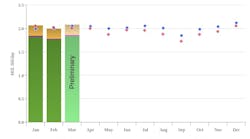Warren R. True
Chief Technology Editor
Oil & Gas Journal
BUENOS AIRES, Oct. 23 -- By Jan. 1 the Malampaya project off the Philippines will be complete, said Managing Director David J. Greer of Shell Philippines Exploration BV, Tuesday at the World Energy Council's World Energy Congress.
From production through transportation and processing, the project represents a combined investment of $4.5 billion, of which $2 billion were devoted to upstream (OGJ Online, Oct. 15, 2001), and is "the largest industrial undertaking in Philippines history."
First gas production arrived a 500 km, 24-in. pipeline at the Tabangao, Batangas Province, gas plant on Luzon Island before the Oct. 1, 2001, deadline set by project sponsors Shell (45%), Texaco Philippines Inc. (45%), and Philippines National Oil Co. (10%).
And by Jan. 1, 2002, first-gas sales will be executed to three new power plants, a 1,200-Mw plant operated by the National Power Corp. at Ilijan, a 1,000-Mw plant at Santa Rita operated by First Gas Power Corp., and a 500-Mw plant at San Lorenzo operated by FGP Corp. All locations are in Batangas province, southern Luzon Island.
Pricing challenges
Greer said the upstream project envisions nine subsea gas wells connected to subsea manifolds on the seabed over Malampaya in 850 m of water. Production from five initial wells supplied the pre-Oct. 1 flow. This first group of wells is clustered around a subsea manifold between Malampaya-1 and Malampaya-4. Drilling of four subsequent wells, said Greer, will take place before 2009 and could call for a second manifold near the Camago area.
He said the four future wells will be of a 7-in. monoborer design with horizontal Christmas trees, "providing high production capacities with a simplified design for long service life." The wells will have permanent downhole gauges to accurately monitor reservoir performance and facilitate effective reservoir management.
Greer said sponsors recognized from the outset that the project could only be successful with full integration of the downstream power projects with the upstream development.
"Upstream's viability depends entirely on the realization of the power projects. By contrast, the power project developers were less dependent on the upstream as their plant would be dual-fired: They could run on liquid fuel and gas ... or their combined purchasing power could support an LNG importation scheme."
Favoring the upstream option, he said, was that the "development of indigenous resources of Malampaya best served the national interest."
Consequently, Shell markets the gas on the basis that its price must underpin the upstream economics. At the same time, said Greer, it must compete with coal-fired power generation, on a total-cost basis, and be cheaper than LNG over the entire chain of its delivery.
Finally, the gas-price adjustment formula links the gas price to oil price fluctuations, thus competing with oil-based power plant fuels.
